
The exclusiveness of Oeteldonkers
Every year during Carnaval, all inhabitants of the Dutch city of Den Bosch, or 'Oeteldonk' during Carnaval, gather to party as 'Oeteldonkers' for three whole days. In fact, every city in the Netherlands gets an alternative name during Carnaval. These names often have something to do with the dialect of that region or with a historic event that is linked to the city. So, every year Den Bosch becomes ‘Oeteldonk’, which translates to 'Frog Hill', from 'oetel' meaning 'frog' and 'donk' meaning 'sandy hill'.
Carnaval is a tradition that is celebrated every year in the Netherlands as well as in many other countries all over the world. In the Netherlands, it is called ‘Carnaval’ and it's mostly celebrated in the southern parts of the country as these used to be Catholic regions. The first day of Carnaval is always exactly six weeks before Easter Sunday since these are the last days before which people would start fasting for religious reasons.
Every region has its own traditions, but in Den Bosch, the capital city of the province of Noord-Brabant, Carnaval is celebrated in a way that is completely different from other regions. The Oeteldonkers have their own unique clothing, unique music and unique habits. In this article, we will look at the indexes that make someone a real Oeteldonker and how this defines the way they celebrate Carnaval.
The origin of Oeteldonkers
Firstly, to understand Oeteldonkers it is important to understand where the tradition of Oeteldonk comes from. Carnaval has been celebrated for over 550 years now. But somewhere around 1880, the parties in Den Bosch started getting out of hand a little too often. People were openly drunk in the streets and the festivities often ended in huge fights. As a result, the bishop started to interfere, wanting to cancel the Carnaval tradition altogether due to all the problems it brought with it.
Instead of obeying his order, the inhabitants of Den Bosch came up with some ideas of their own to protect their folk festival and to keep the tradition of Carnaval alive. They came up with what they called ‘the Oeteldonk formula’. Every inhabitant would be dressed as a farmer during Carnaval and everyone started customizing their own dark blue blouse, their ‘kiel’ in Dutch, to wear as their costume; you see, a 'kiel' is what the cattle farmers wore in those times. A father (later a prince) was chosen to be at the top of the festivities. On October 1st, 1882, ‘de Oeteldonkse Club’ was established, and Oeteldonkers had to make sure that all their ideas were executed correctly to help safeguard the festivities. From that moment on, Carnaval in Oeteldonk was celebrated every year.
De Oeteldonkse Club put out 'de 11 geboden' ('the 11 commandments'): eleven rules that you have to follow if you want to celebrate Carnaval in Oeteldonk.
But there is yet another day also celebrated annually as part of Carnaval: namely, the eleventh of the eleventh, or November 11. Eleven has been known as the 'crazy number' for centuries now. Some say that the reason for this is probably that it is the number that comes before twelve, which is seen as the 'perfect number'. Still, there is no definitive explanation for why people celebrate 11/11 because it is not certain when people started this tradition and why. Nevertheless, it remains an important day for Carnaval as it now marks the beginning of the Carnaval season. However, it should noted that this day has been officially celebrated in Oeteldonk only since 2010.
Another important part of the Oeteldonk tradition is the frog. As mentioned earlier, the name Oeteldonk literally means Frog Hill. Oeteldonk is based on a higher place than its surroundings. In medieval times, this placement of the city had strategic value because you could see your enemies approaching from atop the hill. Also, Oeteldonk's was the only dry sand dune in the scenery; it was surrounded by swamps purposely created to shield the city from intruders and attackers. Legend says that these swamps were filled with frogs. The frog thus became the most important symbol of Oeteldonk although it has not been proven that those swamps were truly filled with frogs. This symbol constructs meaning to Oeteldonk: for all the Oeteldonkers the frog is connected to Carnaval. As Miller-Idriss (2018) puts it, quoting de Saussure: 'One characteristic of a symbol is that it is never wholly arbitrary; it is not empty, for there is the rudiment of a natural bond between the signifier and the signified.' In the case of Oeteldonk, the signifier, namely the frog, a mythical symbol of the city, is now always linked to the signified, namely Carnaval, an intense celebration for the city.
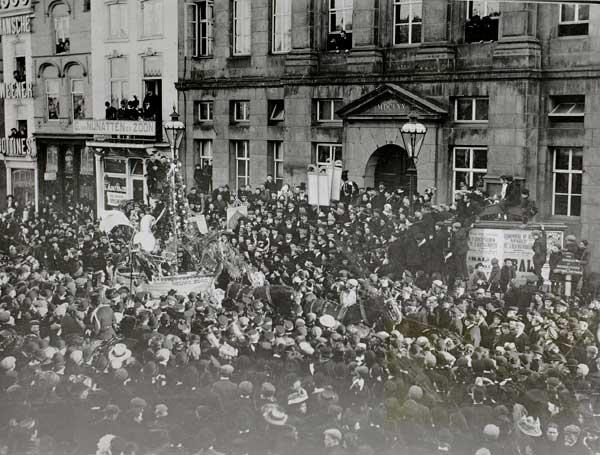
Oeteldonk in its early years
How to become an Oeteldonker
De Oeteldonkse Club put out 'de 11 geboden' ('the 11 commandments'): eleven rules that you have to follow if you want to celebrate Carnaval in Oeteldonk. Rules include having to wear red, white and yellow and having to dance to the music of the different Carnaval clubs. Other rules are based on the ideas that everyone is welcome and that no one is worth more than another person. In a way, you could say that these rules were made to try to include as many people as possible in the celebrations. Yet, this is not entirely true since you can only be included if you adapt to the standards of Oeteldonkers.
Adapting to these rules can be seen as a form of identity work (Maly & Varis, 2015). According to Maly and Varis (2015), '[t]he features are rarely organised at random; when they appear, they are presented and oriented towards as ‘essential’ combinations of emblematic features that reflect, bestow and emphasise one’s ‘authenticity’ as a specific kind of person'. In the process of trying to become an Oeteldonker, the features that one owns reflect the specific kind of person they want to be: an Oeteldonker. This includes wearing the right outfit and colours but also displaying the right behaviour according to the eleven commandments.

The eleven commandments
Oeteldonkers can be described as a social group. To understand the dynamics of a social group, according to Maly and Varis (2015), we have to look at 'the identity indexicals that produce ‘authenticity’ as members of specific populations, the accompanying authenticity discourse, as well as the material (online and offline) infrastructures, and the consequent material effects in (e.g. urban) spaces they entail'.
At first, being an Oeteldonker was quite easy: you had to live in Den Bosch and wear a 'kiel' (a blouse). However, the identity indexicals for Oeteldonkers have since become more complex, in large part because of digitalization. Nowadays, being an Oeteldonker is not only about looking the right way; it is also about displaying the right behaviour online and keeping up with trends, as we will see in examples below. A certain degree of enoughness (Maly and Varis, 2015) is involved in becoming an Oeteldonker; that is, you have to display enough relevant indexes to be considered an authentic Oeteldonker. More precisely, enoughness literally means that 'one has to have, display and enact ‘enough’ of the emblematic features in order to be ratified as an authentic member of an identity category'.
The identity indexicals for being a true Oeteldonker have become more complex, in large part because of digitalization.
The most crucial aspect of the Oeteldonk indexicality, a rule that is also mentioned in the eleven commandments, concerns colours. The colours of Oeteldonk are red, white and yellow. The combination of white and yellow refers to the pope while red and white refers to the flag of Noord-Brabant, the local region. These colours are seen everywhere during the festivities: on the streets, in the cafés, on the decorations and on the people. Every authentic Oeteldonker owns a scarf and matching gloves in the right colours, which should be worn throughout Carnaval. You can thus immediately recognize someone who is not a real Oeteldonker if he or she is not dressed in the colours of Oeteldonk. Women also add other accessories to their outfit, like earrings or bracelets in red, white and yellow. Many also like to paint the Oeteldonk flag on their cheeks or even all over their face. Wearing the right colours is definitely an index for being an authentic Oeteldonker.
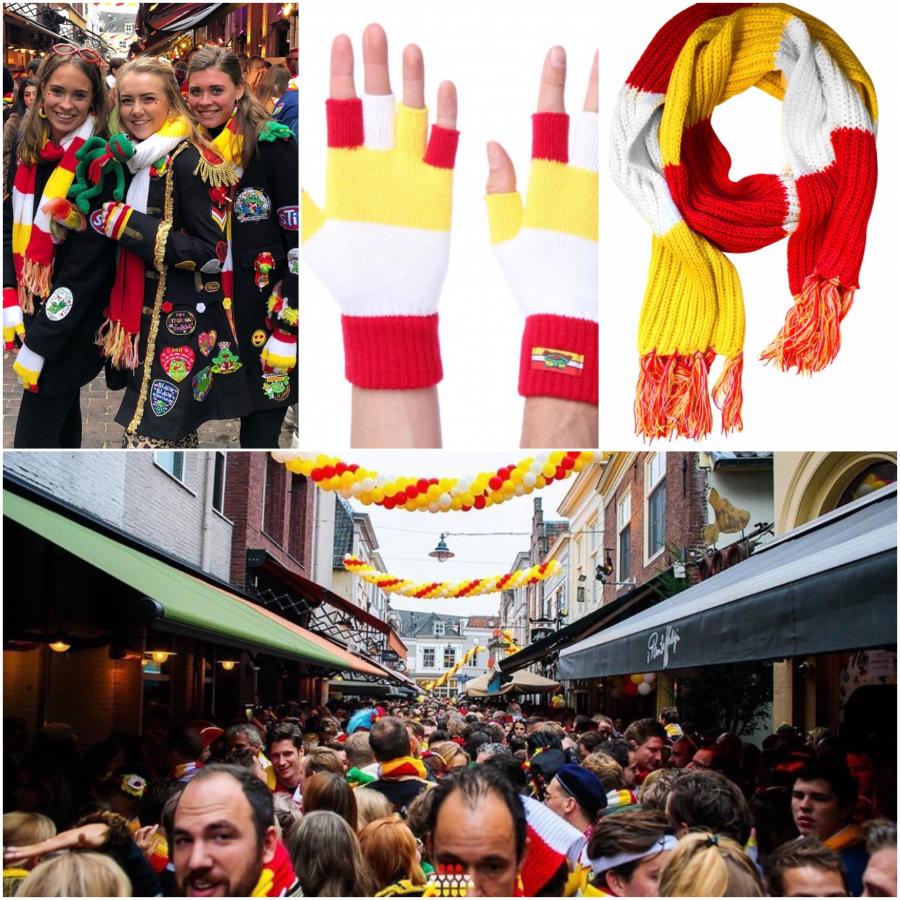
The Oeteldonk colors are visible everywhere
Further, in addition to having to wear a blouse, as mentioned above, you also have to decorate this blouse with emblems and accessories to be a true Oeteldonker. Every year, de Oeteldonkse Club comes up with a theme for Carnaval and every year gets its own emblem. Inhabitants of Den Bosch and its surroundings can send in a handmade design for the emblem and the jury of de Oeteldonkse Club decides which design is chosen. You can recognize an authentic Oeteldonker if you see them having a series of yearly emblems on their 'kiel'.
However, due to digitalization, the internet has become more important these days for choosing which new emblems to buy every year. For example, in 2017 a boy from Den Bosch created an 'America first, Oeteldonk eleventh' emblem and sent it to some friends as a joke. His friends then sent this design to the social media account Oeteldonk Online. Oeteldonk Online ended up using the emblem in a video where they talk about Oeteldonk being the best city in the Netherlands. This was meant as a joke, of course, being a satire of Donald Trump’s statements.
The design was then picked up by a woman who decied to make it into a real emblem, only making two such emblems at first. Yet, as the emblem was shared heavily on social media, more and more people started messaging the designer via Facebook asking for an emblem. Eventually, a waiting list was created and people could only order the emblem via Facebook. This is the perfect example of how digitalization is getting more and more important to Oeteldonkers.
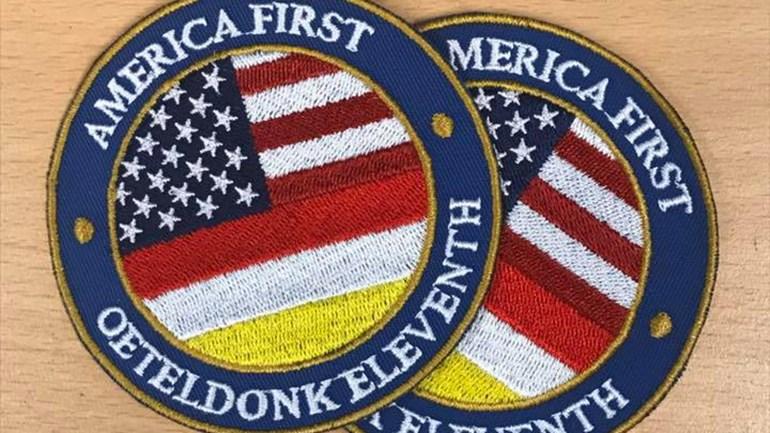
The "America First, Oeteldonk Eleventh" emblem
Lastly, the most important part of the appearance of an Oeteldonker are the 'oetels', the frogs. Frogs, just like the Oeteldonk colours, can be found everywhere throughout the city. They are most prominent on the 'kiel' of every inhabitant, but frogs are also in every logo, every emblem and every café. Some people sew plush frogs onto their 'kiel' or paint a frog on their face. This might be essential considering that if you don't wear any kind of frog, you are not considered an Oeteldonker at all.
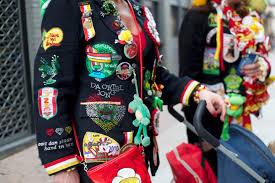
Frogs are heavily present on this woman's kiel
The behaviour of an authentic Oeteldonker
Apart from all the indexes of appearance, authentic Oeteldonkers have some behavioural indexes characterising them as well. If you want to celebrate Carnaval in Oeteldonk, there are some rules you have to obey on how to behave. If you do not follow these rules, you are excluded by other Oeteldonkers.
For one, the eleven commandments state that everyone should speak the language of 'kodder en gein', which means that everyone should speak nicely to one another and not take things too seriously. In practice, this is not always the case. On November 11 of this year, a friend of mine from the province of Drenthe wanted to celebrate Carnaval with me in Den Bosch. Naturally, he did not own a 'kiel' or any accessories in the colours of Oeteldonk. Since my brother was not celebrating 11/11, he could lend him his attire, and I brought these with me to the city. My friend was running a bit late so we decided to go inside a bar already and I would hand the clothes over to him when he got inside. However, when my friend showed up at the door of the bar, the bouncer would not let him in since he was not wearing Oeteldonk clothing and thus was not an authentic Oeteldonker. I came to the door and my friend had to change in front of the bouncer just to show him that he was indeed 'a real Oeteldonker'. This is a perfect example of why Oeteldonkers can be seen as a social group. According to Becker (1997):
'ALL social groups make rules and attempt, at some times and under some circumstances, to enforce them. Social rules define situations and the kinds of behaviour appropriate to them, specifying some actions as "right" and forbidding others as "wrong." When a rule is enforced, the person who is supposed to have broken it may be seen as a special kind of person, one who cannot be trusted to live by the rules agreed on by the group. He is regarded as an outsider.'
From the perspective of an Oeteldonker, celebrating Carnaval their way is mainstream practice; that makes everyone who does not participate following the same rules an outsider.
When you put this in the perspective of Oeteldonk, the outsiders are the people that do not obey the rules enforced by the Oeteldonkers. They cannot follow the behaviour that is appropriate, so that makes them deviant.
However, it is interesting to turn this around. The whole southern part of the Netherlands celebrates Carnaval, but Oeteldonkers are the only ones who do not dress up, because they wear a 'kiel' all the time, and thus see themselves as a different group than other people. In that case, we could say that people who celebrate Carnaval are mainstream and the Oeteldonkers are the deviant ones. The mainstream refers to the attitudes and actions shared by most people. Since Oeteldonkers are a very small part of the people who celebrate Carnaval in total, they could be seen as the ones who are deviant. However, from the perspective of an Oeteldonker, celebrating Carnaval their way is mainstream practice; that makes everyone who does not participate following the same rules an outsider (Becker, 1997).
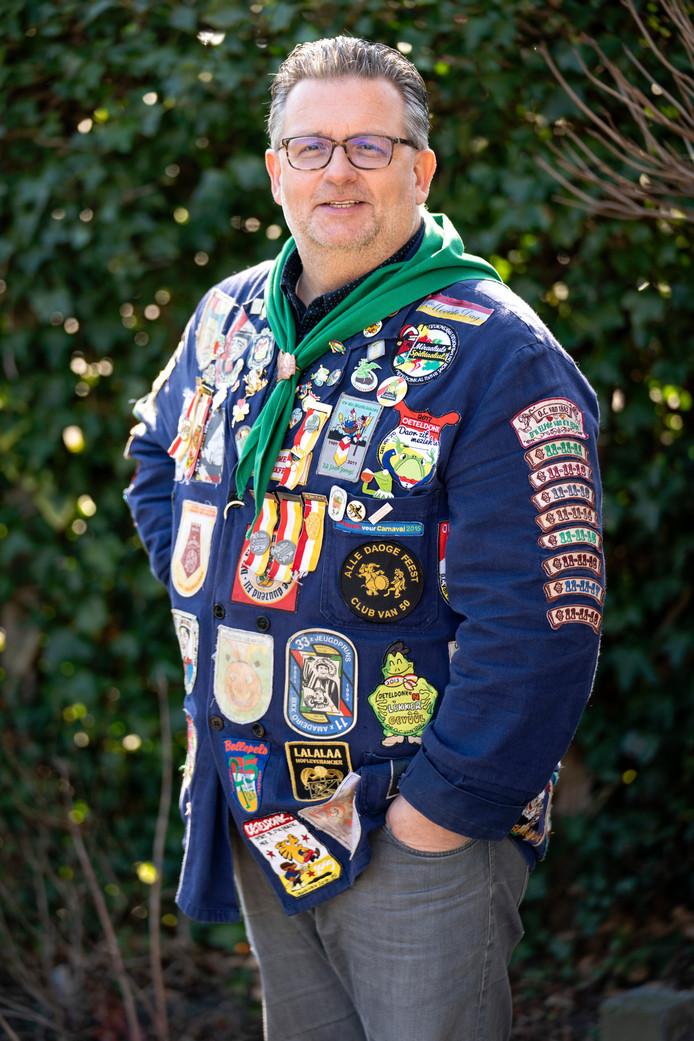
This man is considered an "authentic Oeteldonker" because he is wearing a kiel
The online aspect of Oeteldonk
Oeteldonkers also show their own characteristic behaviour on social media. For example, since Instagram grants the option to tag a location to a post, after Carnaval 2017, people would post pictures of Carnaval and add 'Oeteldonk 2018' as the location; after Carnaval 2018, people would post pictures with the location 'Oeteldonk 2019' and so on. This is not a written rule but it has become an online tradition for Oeteldonkers in the last few years. Nobody is exactly sure why and even the Oeteldonkers themselves do not know the reason behind this, but tagging the location of the festivities with its special name is now typical for Instagram pictures from Oeteldonk. People who are not from Oeteldonk do not participate in this trend so mentioning this location is part of what it means to be an authentic Oeteldonker.
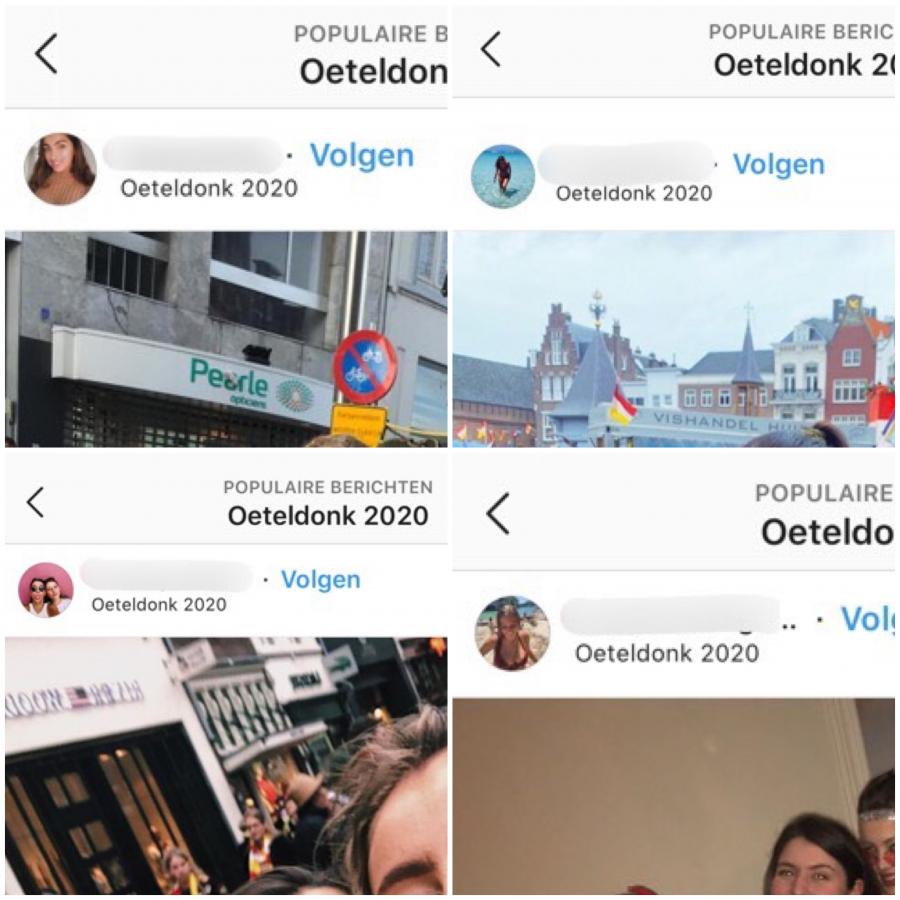
Examples of Instagram posts where people used the location "Oeteldonk 2020". These posts are all from Carnaval 2019, since Carnaval 2020 has not taken place yet
Additionally, almost every popular café or bar in Den Bosch has a Facebook page where they share news that concerns Carnaval. Every year lots of bars make their own emblem, which you can make a reservation for or enter competitions for a chance to win them via their Facebook page. Once you own the emblem, you will have priority in entering the bar during Carnaval if there is a line. Showing the emblem to the bouncer allows you to skip the line.
Another example of how social media are used for Oeteldonkers is the sharing of special discounts or contests through which people can win exclusive Oeteldonk gear. Bakeries make special Oeteldonk cakes and share pictures of them on social media so people will order them. After all, to be a real Oeteldonker nowadays also means to follow the news about Carnaval on social media and be up-to-date about contests to win exclusive goods and merch.
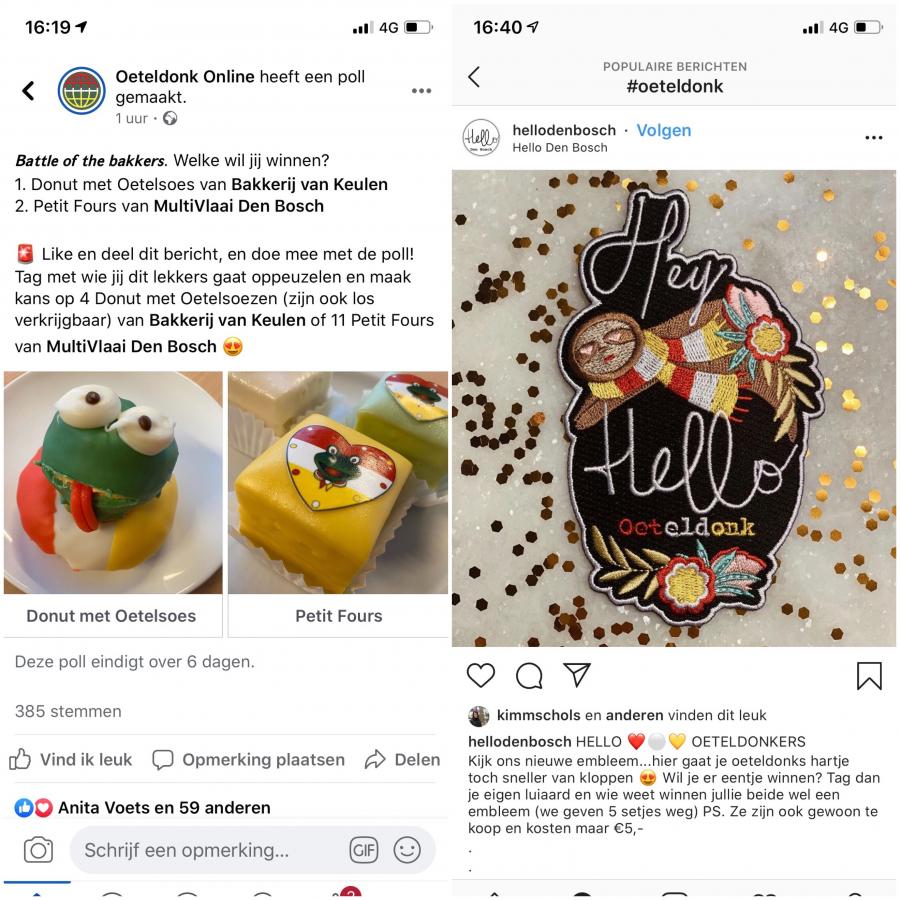
Examples of contests where people can win exclusive Oeteldonk gear
This is an example of how social media can create an even clearer distinction between Oeteldonkers and non-Oeteldonkers, because, for instance, you can be excluded from certain bars if you do not own the right emblem. Social media might be seen as a tool to level inequality but often the opposite is true according to boyd (2015). As she states in her book It's complicated: 'the existence of new technology neither creates nor magically solves cultural problems. In fact, their construction typically reinforces existing social divisions.' This is clearly visible in the case of Oeteldonk not being accessible to everyone; if you don't live in Den Bosch, you have probably never heard of its most popular bars, and thus you do not follow these bars on social media. As a result, you will not be up-to-date on the yearly emblems, which can cost you not being admitted to the parties. This indeed reinforces social divisions.
Further, social media also plays an important role in the music that is played during Carnaval. The eleven commandments state that everyone should dance to the music of the different Carnaval clubs. Every year, new or existing artists bring out Carnaval songs which they post on their Facebook or YouTube. An example from 2019 is this song, which is about Oeteldonkers wanting to send other people away, back to their own part of the Netherlands. Such songs are shared by Oeteldonkers so that as many people as possible will hear them. People who are not from Den Bosch are probably not interested in such songs since they do not understand the dialect used by the singers or they do not get to hear these songs at all because they are not in a Den-Bosch-based circle of people on social media. These people are instantly recognized as outsiders by Oeteldonkers because a true Oeteldonker is acquainted with the new songs. This makes the music played in Oeteldonk unique and mostly liked by inhabitants of Den Bosch because they are the only ones who understand it.
It's also worth noting that this music is only played during Carnaval and never during other times of the year. Social media is crucial to this important part of the Oeteldonk tradition because without music there would be no party. Without social media there would be fewer new Carnaval songs spreading through the population every year. At the same time, this new music keeps the tradition modern.
In conclusion
Oeteldonkers can be seen as a social group who consider themselves mainstream but are seen as outsiders by the rest of people who celebrate Carnaval. It is possible to be a part of this community if you are an outsider but it is difficult. Also, you have to have enough indexes to be considered an Oeteldonker: you have to buy the right commodities, know all the right songs and display the right behaviour offline and on social media. It is not enough to only wear a coloured scarf or to know some traditional songs by heart. All of the characteristics mentioned in this article need to be present for an individual to be considered an authentic Oeteldonker.
References
Becker, H. S. (1997), Outsiders. London: Free Press
boyd, d. (2015). It’s complicated. London: Yale University Press
Maly, I. & Varis, P. (2015), The 21st century hipster: on micro-populations in times of super-diversity. European Journal of Cultural Studies, 19(6), 637–653. https://doi.org/10.1177/1367549415597920.
Miller-Idriss, C. (2018), What makes a symbol far right? Co-opted and missed meanings in far-right iconography. In M. Fielitz & N. Thurston (Eds.), Post-digital cultures of the far right. Online actions and offline consequences in Europe and the US (pp. 123-135). Transcript Independent Academic Publishing.
Official Oeteldonk page, https://www.oeteldonk.org
Wikipedia, Carnival in the Netherlands, https://en.wikipedia.org/wiki/Carnival_in_the_Netherlands